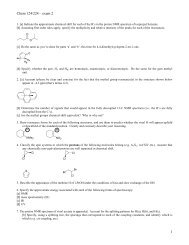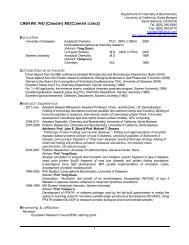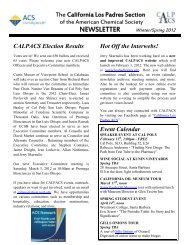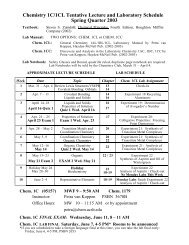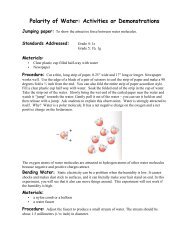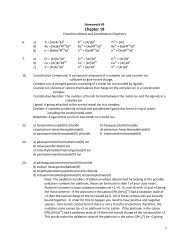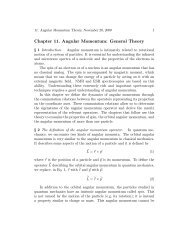Chapter 7. The Eigenvalue Problem
Chapter 7. The Eigenvalue Problem
Chapter 7. The Eigenvalue Problem
Create successful ePaper yourself
Turn your PDF publications into a flip-book with our unique Google optimized e-Paper software.
<strong>7.</strong> <strong>The</strong> <strong>Eigenvalue</strong> <strong>Problem</strong>, December 17, 2009 14<br />
Section <strong>7.</strong>2. Degenerate eigenvalues<br />
§ 10 Introduction. <strong>The</strong> eigenvalues of a matrix A are the roots of the<br />
characteristic polynomial det[A − λI]. <strong>The</strong>re is no law that prevents some<br />
of these roots from being equal. When two or more eigenvalues are equal,<br />
we say that they are degenerate and the corresponding eigenvectors are also<br />
called degenerate. This name suggests a certain moral depravity for these<br />
eigenvalues and I am sure that they find it offensive. I could not find who<br />
introduced this terminology. Mathematiciansaremorepoliteanduseinstead<br />
the terms ‘multiple’ and ‘single’ eigenvalues, which is simpler and friendlier.<br />
One would think that finding operators that have identical eigenvalues<br />
should be as rare as finding by accident polynomials with multiple roots.<br />
But this is not so. Degenerate eigenvalues are fairly frequent and here I use<br />
two examples to suggest why.<br />
§ 11 Particle in a cubic box with infinite potential-energy walls. One of<br />
the simplest models in quantum mechanics is a particle in a rectangular<br />
parallelepiped whose walls are infinitely repulsive. <strong>The</strong> Hamiltonian is<br />
Ĥ = ˆK x + ˆK y + ˆK z (70)<br />
where<br />
ˆK x = − ¯h2 ∂ 2<br />
(71)<br />
2m ∂x 2<br />
is the operator representing the kinetic energy of the motion in direction x;<br />
ˆK y and ˆK z are defined similarly. In classical mechanics, the total kinetic<br />
energy is<br />
p 2<br />
2m = p2 x<br />
2m + p2 y<br />
2m + p2 z<br />
(72)<br />
2m<br />
where p is the momentum vector and p x is the momentum in the direction<br />
x (and analogously for p y , p z ). <strong>The</strong> operator ˆK x is the quantum analog of<br />
p 2 x/2m.<br />
<strong>The</strong> total energy of the particle is discrete and is given by (see H. Metiu,<br />
Physical Chemistry, Quantum Mechanics, page 104)<br />
E n,j,k = ¯h2 π 2<br />
2m<br />
n 2 ¯h 2 π 2 2<br />
j<br />
+ + ¯h2 π 2 2<br />
k<br />
(73)<br />
L x 2m L y 2m L z




